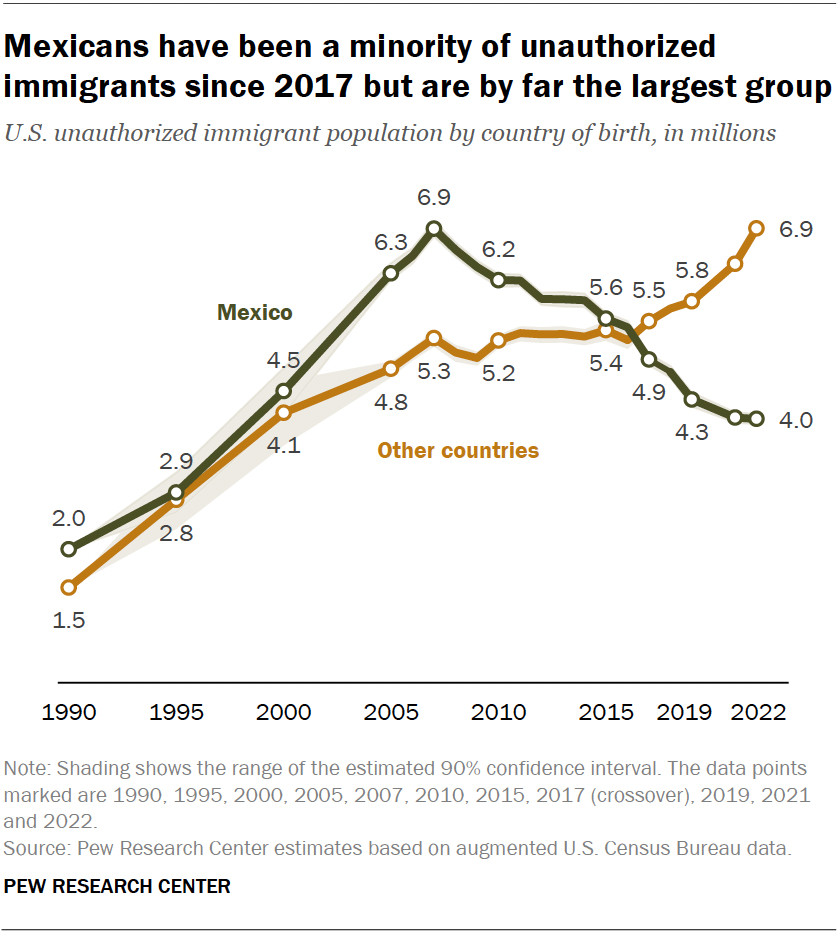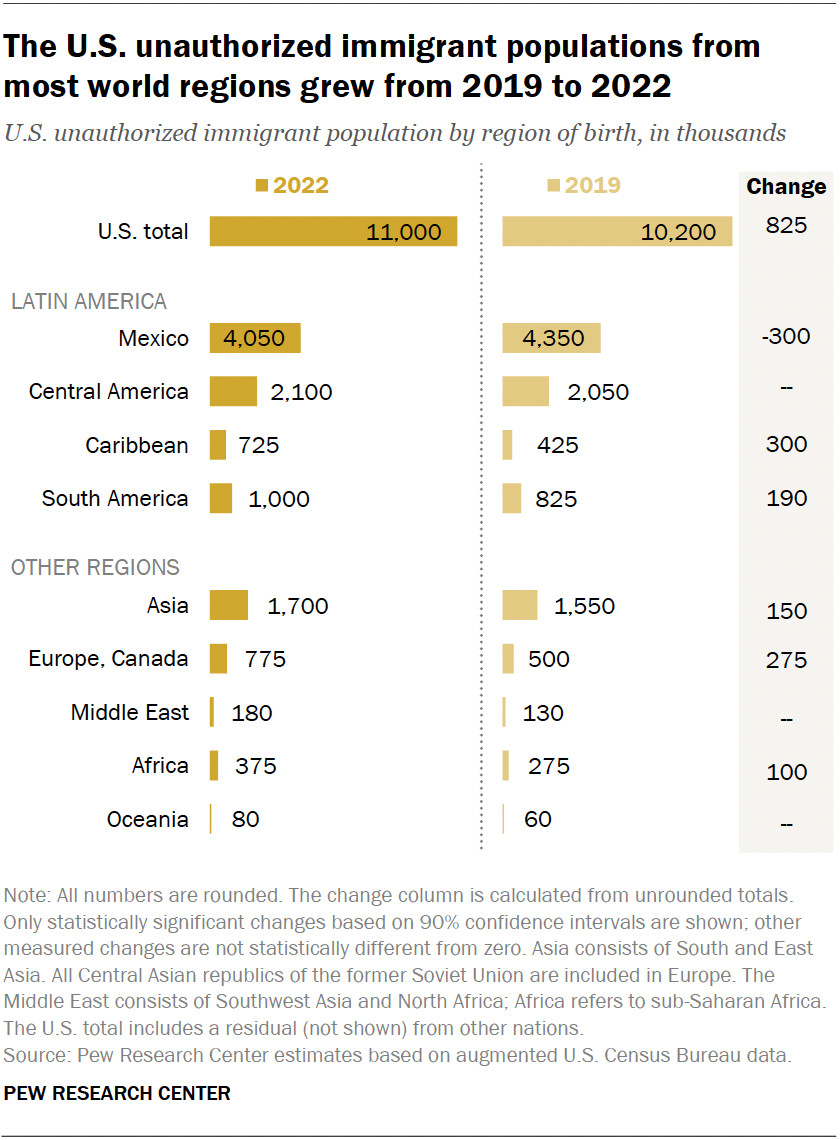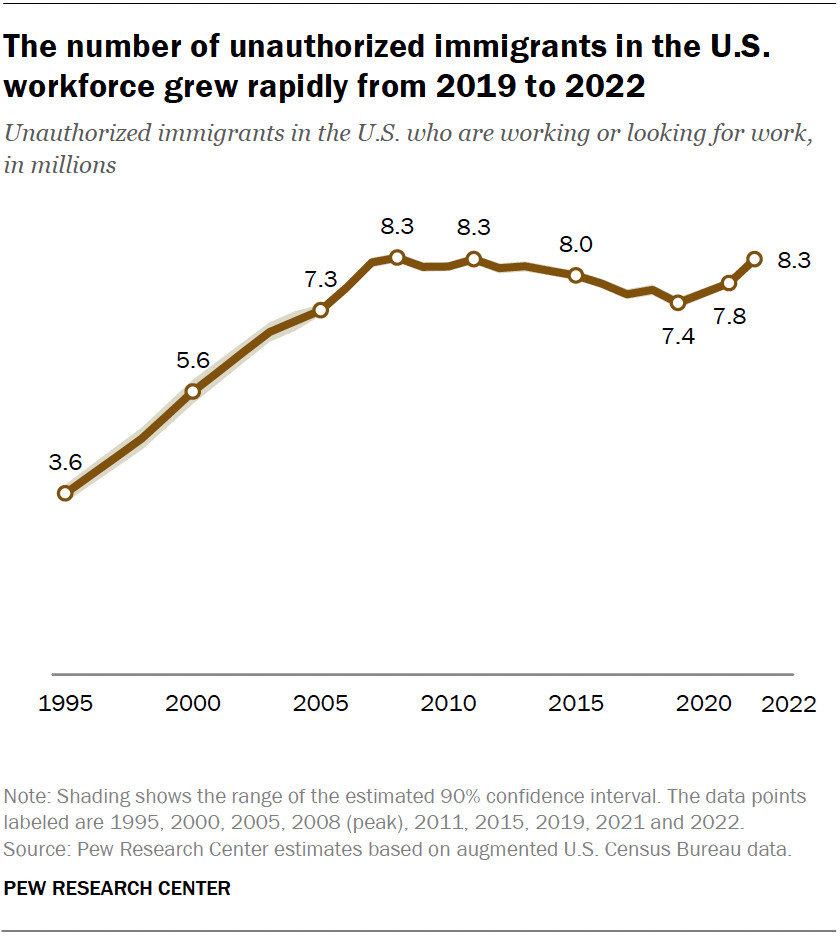How Many Illegal Immigrants Are From Mexico? Gaymexico.net explores the numbers and trends of undocumented Mexican immigrants in the U.S., providing insights relevant to the LGBTQ+ community and allies. Understanding these demographics helps us better advocate for inclusive and just immigration policies, and this article dives deep into the topic while offering resources for support and connection. Let’s explore immigration policies, undocumented residents, and migrant experiences.
1. Understanding the Numbers: Mexican Unauthorized Immigrants in the U.S.
In 2022, there were approximately 4.0 million unauthorized immigrants from Mexico living in the U.S., marking the lowest figure since the 1990s. This figure represents 37% of the total unauthorized immigrant population in the U.S., the smallest share on record according to the Pew Research Center.
To fully grasp the dynamics of this population, let’s delve into the contributing factors and broader implications:
- Historical Context: The number of unauthorized immigrants from Mexico peaked at 6.9 million in 2007. Since then, there has been a notable decline due to several factors, including decreased migration from Mexico to the U.S., some Mexican immigrants returning to Mexico, and expanded opportunities for legal immigration, particularly for temporary agricultural workers.
- Demographic Shifts: While the Mexican unauthorized immigrant population has decreased, it’s essential to note that the overall unauthorized immigrant population in the U.S. has seen shifts in composition. From 2019 to 2022, the unauthorized immigrant population from nearly every other region of the world grew, including the Caribbean, South America, Asia, Europe, and sub-Saharan Africa.
- Economic Factors: Economic conditions in both Mexico and the U.S. play a significant role in migration patterns. Improved economic opportunities in Mexico can reduce the incentive to migrate to the U.S. without authorization.
- Policy Changes: Changes in U.S. immigration policies can also influence the number of unauthorized immigrants from Mexico. Increased border enforcement and stricter immigration laws may deter unauthorized immigration.
- Community Impact: Understanding these numbers is crucial for informing policies and initiatives that support immigrant communities, including LGBTQ+ individuals. Gaymexico.net aims to provide resources and information that promote inclusivity and understanding within these communities.
 A line chart showing that Mexicans have been a minority of unauthorized immigrants since 2017 but are by far the largest group.
A line chart showing that Mexicans have been a minority of unauthorized immigrants since 2017 but are by far the largest group.
2. What Factors Contribute to the Decline in Unauthorized Immigrants from Mexico?
Several factors contribute to the decline in unauthorized immigrants from Mexico, including decreased migration, return migration, and expanded legal immigration opportunities. Specifically, the 4.0 million unauthorized immigrants from Mexico in 2022 was the lowest number since the 1990s, with Mexico accounting for the smallest share on record at 37% of the nation’s unauthorized immigrants.
Examining these factors in detail provides a comprehensive understanding:
- Decreased Migration from Mexico: There has been a broader decline in migration from Mexico to the U.S. This can be attributed to various reasons, such as improved economic conditions in Mexico, which reduce the incentive to migrate.
- Return Migration to Mexico: Some Mexican immigrants have been returning to Mexico, either voluntarily or due to deportation. This reverse migration contributes to the decline in the unauthorized immigrant population.
- Expanded Legal Immigration Opportunities: Opportunities for legal immigration from Mexico and other countries have expanded, particularly for temporary agricultural workers. This allows individuals to immigrate through legal channels rather than entering the U.S. without authorization.
- Border Enforcement: Increased border enforcement and stricter immigration policies in the U.S. may deter potential unauthorized immigrants from attempting to enter the country.
- Economic Opportunities in Mexico: Economic growth and job creation in Mexico can provide alternatives for individuals who might otherwise seek opportunities in the U.S.
- Social Networks: Changes in social networks and community support can also influence migration patterns. If fewer people in a community are migrating to the U.S., others may be less likely to do so as well.
- Policy and Advocacy: Understanding these factors helps inform policies and advocacy efforts that support immigrant communities. Gaymexico.net is committed to providing resources and information that promote inclusivity and understanding within these communities.
3. How Has the Composition of the Unauthorized Immigrant Population Changed Over Time?
From 2019 to 2022, the unauthorized immigrant population from nearly every region of the world grew, with the exception of Central America. This shift indicates a diversification of the unauthorized immigrant population in the U.S.
Here’s a breakdown of the changes:
- Growth in Other Regions: The unauthorized immigrant population from regions such as the Caribbean, South America, Asia, Europe, and sub-Saharan Africa has increased. This suggests that factors driving unauthorized immigration are becoming more diverse and widespread.
- Central America: Unlike other regions, Central America did not see significant growth in its unauthorized immigrant population after 2019. This could be due to specific policies or conditions affecting migration from this region.
- Top Countries of Origin: After Mexico, the countries with the largest unauthorized immigrant populations in the U.S. in 2022 were El Salvador (750,000), India (725,000), Guatemala (675,000), and Honduras (525,000).
- The Northern Triangle: El Salvador, Honduras, and Guatemala (the Northern Triangle) collectively represented 1.9 million unauthorized immigrants in the U.S. in 2022, about 18% of the total.
- Venezuela: In 2022, Venezuela was the country of birth for 270,000 U.S. unauthorized immigrants, showing particularly fast growth from 55,000 in 2007 to 130,000 in 2017.
- Other Countries: Brazil, Canada, Colombia, Ecuador, India, and countries of the former Soviet Union also experienced growth from 2019 to 2022.
- No Change: China, the Dominican Republic, and the Philippines showed no significant change in their unauthorized immigrant populations.
- Implications: These shifts in composition have implications for policy and resource allocation, highlighting the need for tailored approaches to address the diverse needs of immigrant communities. Gaymexico.net supports these communities by providing resources and fostering understanding.
 A bar chart showing that the U.S. unauthorized immigrant populations from most world regions grew from 2019 to 2022.
A bar chart showing that the U.S. unauthorized immigrant populations from most world regions grew from 2019 to 2022.
4. Which States Have Experienced Growth in Their Unauthorized Immigrant Populations?
From 2019 to 2022, six states experienced significant growth in their unauthorized immigrant populations: Florida, Texas, New York, New Jersey, Massachusetts, and Maryland. In contrast, California was the only state that saw a decrease.
Let’s break down the specifics:
| State | Increase/Decrease |
|---|---|
| Florida | +400,000 |
| Texas | +85,000 |
| New York | +70,000 |
| New Jersey | +55,000 |
| Massachusetts | +50,000 |
| Maryland | +40,000 |
| California | -120,000 |
- States with the Largest Populations: In 2022, the six states with the largest unauthorized immigrant populations were California (1.8 million), Texas (1.6 million), Florida (1.2 million), New York (650,000), New Jersey (475,000), and Illinois (400,000).
- Geographic Shift: The unauthorized immigrant population has become less geographically concentrated over time. In 2022, the top six states were home to 56% of the nation’s unauthorized immigrants, down from 80% in 1990.
- Impact on Communities: Understanding these shifts is vital for addressing the needs of immigrant communities, including LGBTQ+ individuals. Gaymexico.net offers resources and support to foster inclusive and welcoming environments.
- Policy Implications: These trends highlight the need for comprehensive immigration policies that consider the diverse needs of different states and regions.
- Economic Impact: The increase in certain states can impact local economies, labor markets, and social services, requiring careful planning and resource allocation.
5. What Percentage of the U.S. Workforce is Comprised of Unauthorized Immigrants?
In 2022, approximately 8.3 million U.S. workers were unauthorized immigrants, representing about 4.8% of the total U.S. workforce. This number equals previous highs in 2008 and 2011.
Key insights:
- Historical Context: The share of unauthorized immigrants in the U.S. workforce has remained relatively stable since 2003, ranging from 4.4% to 5.4%.
- Comparison to Total Population: The share of the U.S. workforce made up by unauthorized immigrants (4.8%) is higher than their share of the total U.S. population (3.3%). This is because the unauthorized immigrant population includes relatively few children or elderly adults, who are less likely to be in the labor force.
- State Variations: The share of unauthorized immigrants in the workforce varies across states. Nevada (9%), Texas (8%), Florida (8%), New Jersey (7%), California (7%), and Maryland (7%) had the highest shares in 2022.
- Economic Role: Unauthorized immigrants play a significant role in certain sectors of the U.S. economy, such as agriculture, construction, and hospitality.
- Labor Force Participation: Understanding the labor force participation of unauthorized immigrants is crucial for informing policies related to immigration, labor, and economic development.
- Community Support: Gaymexico.net recognizes the contributions of all individuals to the U.S. workforce and supports policies that promote fair labor practices and economic opportunities for all.
- Policy and Advocacy: Knowledge of these statistics is essential for advocating for policies that protect workers’ rights and ensure fair treatment in the workplace.
 A line chart showing the number of unauthorized immigrants in the U.S. workforce grew rapidly from 2019 to 2022.
A line chart showing the number of unauthorized immigrants in the U.S. workforce grew rapidly from 2019 to 2022.
6. How Do Temporary Protected Status (TPS) and Deferred Action for Childhood Arrivals (DACA) Affect These Numbers?
Temporary Protected Status (TPS) and Deferred Action for Childhood Arrivals (DACA) are programs that provide temporary protection from deportation and work authorization to certain unauthorized immigrants. As of July 2022, approximately 3 million immigrants had temporary protection from deportation, accounting for almost 30% of the national estimate of 11.0 million unauthorized immigrants.
Here’s a detailed look:
- Temporary Protected Status (TPS): TPS allows eligible migrants to live and work in the U.S. and avoid deportation because their home countries are unsafe due to war, natural disasters, or other crises. As of early 2024, the population of immigrants eligible for or receiving TPS was about 1.2 million.
- Deferred Action for Childhood Arrivals (DACA): DACA allows unauthorized immigrants who were brought to the U.S. before their 16th birthday and were in the U.S. on June 15, 2012, to live and work in the country. At the end of 2023, about 530,000 people had DACA status.
- Impact on Estimates: While these programs provide legal protection, individuals under TPS and DACA are still included in estimates of the unauthorized immigrant population. This is because their status is temporary and could be subject to change based on government policy.
- Asylum Seekers: Individuals who have applied for asylum and are awaiting a ruling are also included in the unauthorized immigrant population. As of the end of 2023, the backlog of affirmative asylum cases had increased significantly, adding approximately 870,000 immigrants to the backlog.
- CHNV and U4U Parolees: Programs like the Cuban, Haitian, Nicaraguan, and Venezuelan (CHNV) parole program and Uniting for Ukraine (U4U) allow individuals from these countries to enter the U.S. on a temporary basis. These parolees are also considered part of the unauthorized immigrant population.
- Community Support: Gaymexico.net supports comprehensive immigration reform that provides pathways to legal status for long-term residents of the U.S., including those under TPS and DACA.
- Advocacy and Awareness: Understanding the impact of these programs is crucial for advocating for policies that protect vulnerable immigrant communities and promote stability.
7. How Do Asylum Seekers Fit Into the Statistics of Unauthorized Immigration?
Asylum seekers are included in estimates of the unauthorized immigrant population because they have not been admitted as permanent residents. The number of asylum seekers with pending cases has grown substantially since July 2022.
Here’s a more detailed explanation:
- Affirmative Asylum: These cases are adjudicated by the Department of Homeland Security’s U.S. Citizenship and Immigration Services (USCIS). The backlog of affirmative asylum cases increased from about 500,000 as of June 30, 2022, to more than 1.1 million at the end of 2023.
- Defensive Asylum: These cases are adjudicated by the Department of Justice Executive Office for Immigration Review. During the same period, the backlog for defensive asylum cases grew by about 120,000 people, from about 900,000 to 1 million people.
- Impact on Numbers: The increase in asylum seekers with pending cases has contributed to the overall growth of the unauthorized immigrant population in recent years.
- Legal Context: Individuals seeking asylum are allowed to remain in the U.S. while their cases are being processed. However, until their asylum claims are approved, they are considered part of the unauthorized immigrant population.
- Policy Implications: The large backlog of asylum cases highlights the need for efficient and fair processing systems to ensure that asylum seekers receive timely decisions.
- Support for Asylum Seekers: Gaymexico.net supports policies that provide resources and assistance to asylum seekers, including access to legal representation and social services.
- Advocacy for Fair Treatment: Understanding the challenges faced by asylum seekers is essential for advocating for humane and just immigration policies.
8. What Impact Do Border Encounters Have on Unauthorized Immigration Figures?
U.S. immigration authorities have encountered a large number of migrants at the border since July 2022. While many migrants are detained and denied entry into the U.S., some are allowed to remain in the U.S. temporarily, affecting unauthorized immigration figures.
Key Points:
- Border Patrol Releases and OFO Paroles: The Census Bureau’s population estimates released in December 2024 directly incorporate two groups from these encounters: U.S. Border Patrol Releases (about 1.6 million additional immigrants from July 2022 through the end of 2023) and Office of Field Operations Paroles (about 550,000 additional migrants).
- Temporary Stays: Many of those allowed to stay are included in other groups, such as asylum seekers or those with temporary protected status, and do not represent additional unauthorized immigrants.
- Overall Growth: Despite these encounters, the unauthorized immigrant population has likely grown over the past few years, based on several alternative data sources.
- Policy and Enforcement: Border encounters are a key indicator of migration trends and the effectiveness of border enforcement policies.
- Humanitarian Concerns: The treatment of migrants at the border raises important humanitarian concerns, particularly for vulnerable groups such as LGBTQ+ individuals and families.
- Gaymexico.net’s Role: We advocate for humane and fair treatment of all migrants, including those encountered at the border. We support policies that prioritize the safety and well-being of vulnerable populations.
- Informed Advocacy: Understanding the impact of border encounters on unauthorized immigration figures is crucial for informed advocacy and policy engagement.
9. How Does the U.S. Census Bureau Estimate the Unauthorized Immigrant Population?
The U.S. Census Bureau uses a “residual method” to estimate the unauthorized immigrant population. This method involves several steps:
- Estimate the total number of immigrants living in the country in a particular year using data from U.S. censuses and government surveys such as the American Community Survey and the Current Population Survey.
- Estimate the number of immigrants living in the U.S. legally using official counts of immigrant and refugee admissions together with other demographic data (for example, death and out-migration rates).
- Subtract the estimate of lawful immigrants from the estimate of the total immigrant population. This provides an initial estimate of the unauthorized immigrant population.
- Upward Adjustment: The final estimate includes an upward adjustment to account for the undercount of immigrants in censuses and surveys, as these tend to miss some people, especially unauthorized immigrants.
- Data Sources: The estimates align with official U.S. data sources, including birth records, school enrollment figures, and tax data, as well as Mexican censuses and surveys.
- Consistency with Other Estimates: The Census Bureau’s estimates are generally consistent with those of other organizations, such as the U.S. Department of Homeland Security’s Office of Immigration Statistics, the Center for Migration Studies, and the Migration Policy Institute.
- Importance of Accurate Data: Accurate estimates of the unauthorized immigrant population are essential for informing policy decisions related to immigration, social services, and economic planning.
- Gaymexico.net’s Commitment: We rely on credible data sources like the U.S. Census Bureau to provide accurate information to our community. We advocate for policies based on facts and evidence.
- Promoting Understanding: Accurate data helps promote understanding and reduce misinformation about immigration issues.
10. What Resources Are Available for LGBTQ+ Immigrants in the U.S.?
LGBTQ+ immigrants in the U.S. face unique challenges and may require specialized resources and support. Here are some organizations and resources that can help:
- Immigration Equality: This organization provides legal services to LGBTQ+ immigrants and asylum seekers. They offer free legal consultations and representation in immigration cases.
- Website: https://immigrationequality.org/
- National LGBTQ Task Force: This organization advocates for LGBTQ+ rights and provides resources and support to LGBTQ+ individuals, including immigrants.
- Website: https://www.thetaskforce.org/
- The LGBT Asylum Project: This project provides legal assistance and support to LGBTQ+ asylum seekers. They offer free legal representation and social services.
- Website: https://www.lgbtasylumproject.org/
- Human Rights Campaign (HRC): HRC advocates for LGBTQ+ rights and provides resources and information on immigration issues.
- Website: https://www.hrc.org/
- Center for American Progress: This organization conducts research and advocates for policies that support immigrant communities, including LGBTQ+ immigrants.
- Website: https://www.americanprogress.org/
- Local LGBTQ+ Centers: Many local LGBTQ+ centers offer resources and support to LGBTQ+ immigrants, including legal assistance, social services, and community support.
- Community Support: Gaymexico.net provides a platform for LGBTQ+ individuals and allies to connect, share information, and find support. We are committed to creating a welcoming and inclusive community for all.
- Advocacy and Awareness: By understanding the challenges faced by LGBTQ+ immigrants, we can advocate for policies that protect their rights and promote their well-being.
At Gaymexico.net, we understand the importance of staying informed and connected. Whether you’re planning a visit to Mexico or seeking resources within the U.S., we’re here to support you. Explore our website for more information on LGBTQ+ travel, community events, and valuable resources. Join our community today and discover a world of acceptance, adventure, and connection.
Address: 3255 Wilshire Blvd, Los Angeles, CA 90010, United States
Phone: +1 (213) 380-2177
Website: gaymexico.net
FAQ: Understanding Mexican Immigration to the U.S.
- How many unauthorized immigrants from Mexico reside in the United States?
Approximately 4.0 million unauthorized immigrants from Mexico were living in the U.S. in 2022. - Why has the number of unauthorized immigrants from Mexico decreased?
The decline is due to decreased migration from Mexico to the U.S., return migration to Mexico, and expanded legal immigration opportunities. - What percentage of the total unauthorized immigrant population is from Mexico?
In 2022, Mexican immigrants accounted for 37% of the nation’s unauthorized immigrants. - Which other regions have seen growth in their unauthorized immigrant populations?
The Caribbean, South America, Asia, Europe, and sub-Saharan Africa have all seen increases. - Which U.S. states have experienced growth in their unauthorized immigrant populations?
Florida, Texas, New York, New Jersey, Massachusetts, and Maryland have seen growth. - What percentage of the U.S. workforce is comprised of unauthorized immigrants?
Unauthorized immigrants make up about 4.8% of the U.S. workforce. - How do TPS and DACA affect the statistics of unauthorized immigration?
Individuals under TPS and DACA are included in estimates of the unauthorized immigrant population despite having temporary legal protection. - Are asylum seekers included in the unauthorized immigrant population figures?
Yes, asylum seekers are included until their claims are approved and they obtain permanent residency. - How does the Census Bureau estimate the unauthorized immigrant population?
The Census Bureau uses a “residual method” that subtracts the estimated number of lawful immigrants from the total immigrant population. - What resources are available for LGBTQ+ immigrants in the U.S.?
Organizations like Immigration Equality and the National LGBTQ Task Force offer legal assistance and support.
